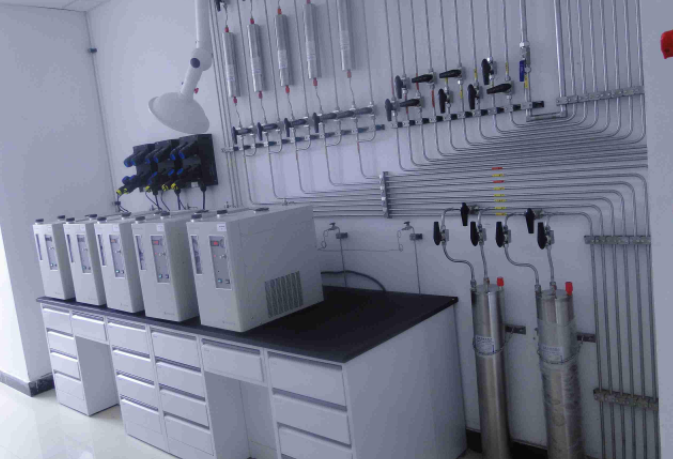The gas pipeline refers to the connecting pipeline between the gas cylinder and the instrument terminal. It generally consists of gas switching device-pressure reducing device-valve-pipeline-filter-alarm-terminal box-regulating valve and other parts. The gases transported are gases for laboratory instruments (chromatography, atomic absorption, etc.) and high-purity gases. Gas Engineering Co., Ltd. can complete turnkey projects for the construction, reconstruction, and expansion of laboratory gas lines (gas pipelines) in various industries.
The gas supply method adopts medium pressure gas supply and two-stage pressure reduction. The gas pressure of the cylinder is 12.5MPa. After one-stage pressure reduction, it is 1MPa (pipeline pressure 1MPa). It is sent to the gas point. After two-stage pressure reduction, it is The air supply pressure is 0.3~0.5 MPa (according to the instrument requirements) and is sent to the instrument, and the air supply pressure is relatively stable.It is non-permeable to all gases, has less adsorption effect, is chemically inert to the transported gas, and can quickly balance the transported gas.
The carrier gas is delivered to the instrument through the cylinder and delivery pipeline. A one-way valve is installed at the outlet of the cylinder to avoid the mixing of air and moisture when replacing the cylinder. In addition, a pressure relief switch ball valve is installed at one end to drain excess air and moisture. After discharge, connect it to the instrument pipeline to ensure the purity of the gas used by the instrument.
The centralized gas supply system adopts two-stage pressure reduction to ensure the stability of the pressure. First, after pressure reduction, the dry line pressure is greatly lower than the cylinder pressure, which plays the role of buffering the pipeline pressure and improves the efficiency of the gas supply system. The safety of gas use reduces application risks. Secondly, it ensures the stability of the gas supply inlet pressure of the instrument, reduces measurement errors caused by gas pressure fluctuations, and ensures the stability of the instrument.
Since some instruments in the laboratory need to use flammable gases, such as methane, acetylene, and hydrogen, when making pipelines for these flammable gases, attention should be paid to keeping the pipelines as short as possible to reduce the number of intermediate joints. At the same time, the gas cylinders must be filled with explosion-proof gas. In the bottle cabinet, the output end of the gas bottle is connected to a flashback device, which can prevent explosions caused by the flame backflow to the gas bottle. The top of the explosion-proof gas bottle cabinet should have a ventilation outlet connected to the outdoors, and there should be a leakage alarm device. In case of leakage, the alarm can be reported in time and Vent gas outdoors.
Note: The pipes with a diameter of 1/8 are very thin and very soft. They are not straight after installation and are very unsightly. It is recommended that all pipes with a diameter of 1/8 be replaced with 1/4, and add a pipe at the end of the secondary pressure reducer. Just change the diameter. The pressure gauge range of the pressure reducer for nitrogen, argon, compressed air, helium, methane and oxygen is 0-25Mpa, and the secondary pressure reducer is 0-1.6 Mpa. The measuring range of the acetylene first-level pressure reducer is 0-4 Mpa, and the second-level pressure reducer is 0-0.25 Mpa. Nitrogen, argon, compressed air, helium, and oxygen cylinder joints share the hydrogen cylinder joints. There are two types of hydrogen cylinder joints. One is the forward rotation cylinder. joint, the other is reversed. Large cylinders use reverse rotation, and small cylinders use forward rotation. Gas pipelines are provided with a pipe fixing piece every 1.5m. Fixing pieces should be installed at the bends and at both ends of the valve. Gas pipelines should be installed along the wall to facilitate installation and maintenance.
Post time: Mar-05-2024


